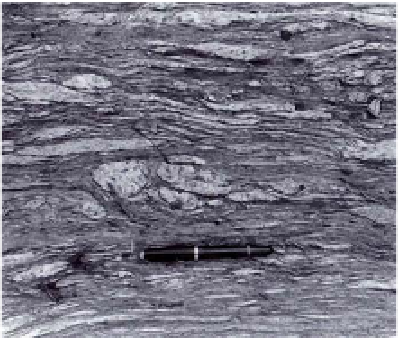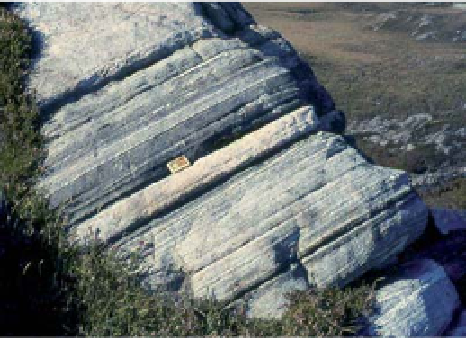Geology Reference
In-Depth Information
consists of the parallel alignment of
planar minerals such as mica and horn-
blende, which is easily visible to the
naked eye (Figures 7.3A, B). It forms
various types of schist designated
by the mineral that most obviously
forms the schistose structure; thus,
for example: biotite schist, muscovite
schist and hornblende schist. Fine-
grained muscovite- or
chlorite
schists
that are intermediate in grade between
slate and schist are known as
phyllite
.
Most, if not all, schists will have started
out as slates and become transformed
into schists with increasing metamor-
phic grade. However, the origin of the
schistosity as a slaty cleavage, and its
relationship to the strain axes, may no
longer be obvious unless it corresponds
to a plane of flattening, as in Figure
7.3A, or is parallel to the axial planes
of related folds, as in Figure 7.3B.
Schists are most commonly formed
in
pelitic
or
semipelitic
metasedi-
mentary rocks, that is, those originat-
ing as mudstones or siltstones with
a relatively high proportion of clay
minerals (
see
Appendix).
Psammites
(metamorphosed sandstones), however,
may also possess a schistosity, perhaps
in thin mica-rich bands, although
such a rock, as a whole, would not
normally be thought of as a schist.
Gneissosity
is a planar fabric con-
sisting of alternating layers or elongate
aggregates of light-coloured minerals
- mainly quartz and feldspar, and
dark-coloured minerals such as mica
and hornblende (Figure 7.3C). It often
accompanies schistosity in coarse-
grained metamorphic rocks that could
therefore be referred to as 'schistose
gneisses'. Many gneisses are formed
from highly deformed, coarse-grained
igneous rocks such as granite, in which
the quartzo-feldspathic components
have been concentrated into bands or
lenses as a result of deformation, as
in Figure 7.3D. The relationship of the
gneissosity to the strain state of the
deformed rock is often fairly obvious,
particularly in igneous rocks containing
phenocrysts or megacrysts that have
been deformed into lensoid shapes
Figure 7.3
Schistosity and
gneissosity.
A.
Schistosity
corresponding to the plane of
flattening of deformed pebbles
in conglomerate.
B.
Axial planar
schistosity in hornblende schist;
the schistosity (parallel to the
red line) is caused by the parallel
alignment of hornblende crystals,
which is more marked in the
central band and is less obvious
in the outer bands. The image is
from a thin section, 2 cm across.
C.
Banded granitic gneiss with
alternating pink granitic layers
and dark, schistose, biotite-rich
layers. Note 10p coin for scale.
D.
Banded and striped gneiss
produced by very high strain in a
shear zone. Note matchbox for
scale.
A
B
C
D






Search WWH ::

Custom Search